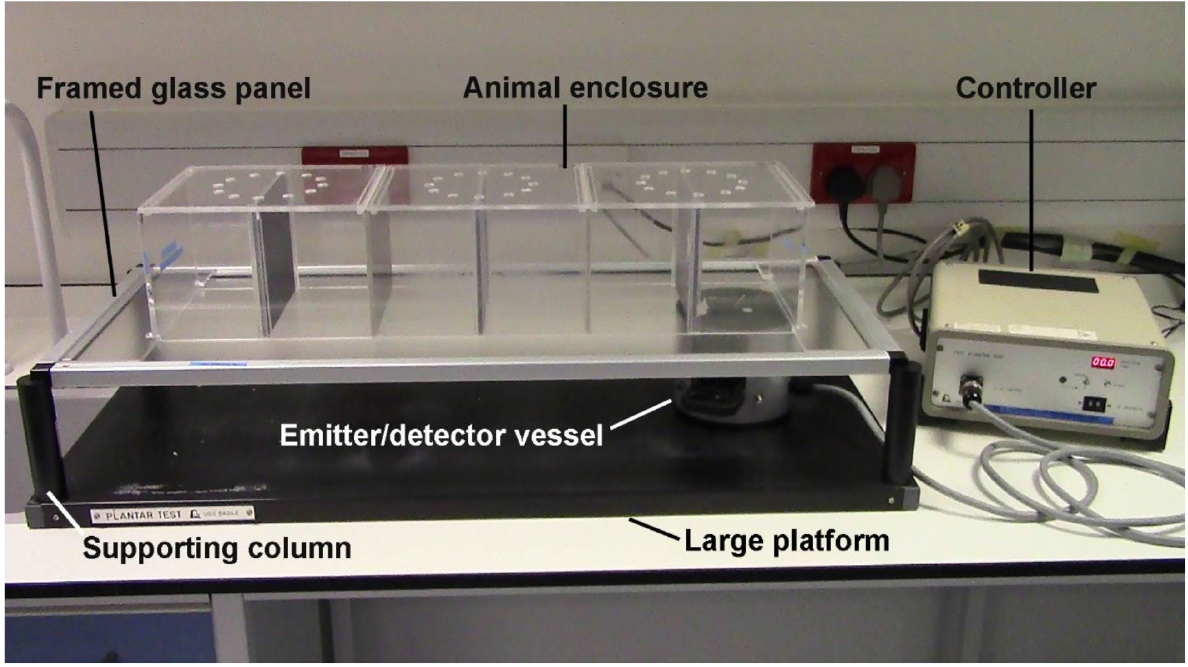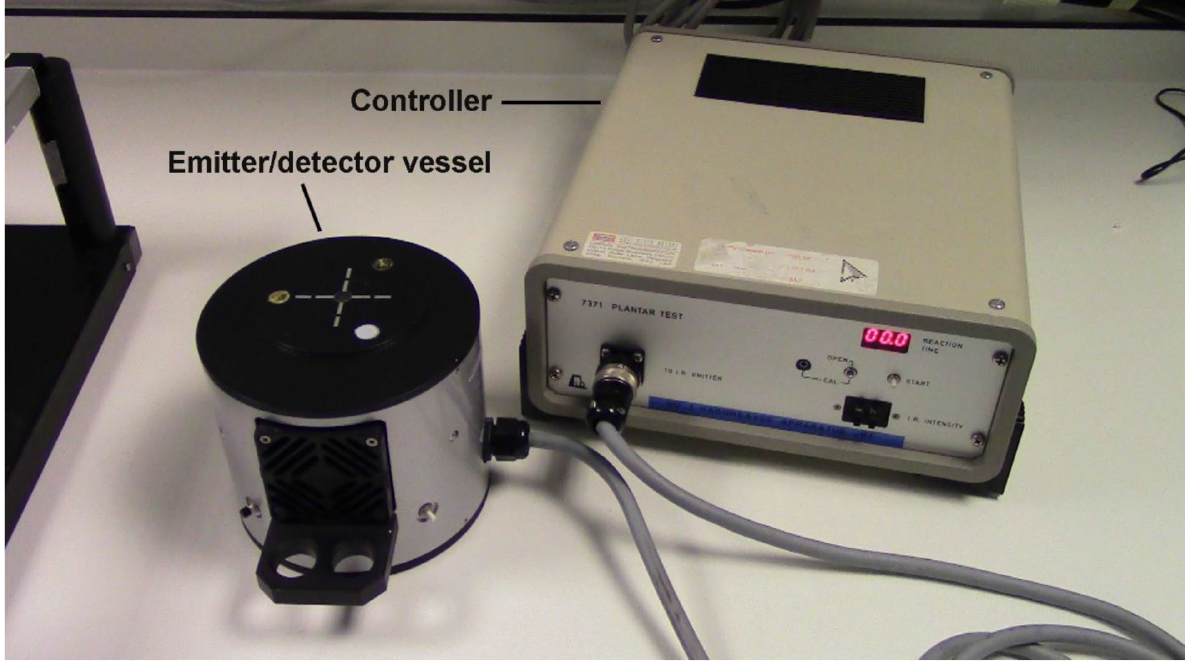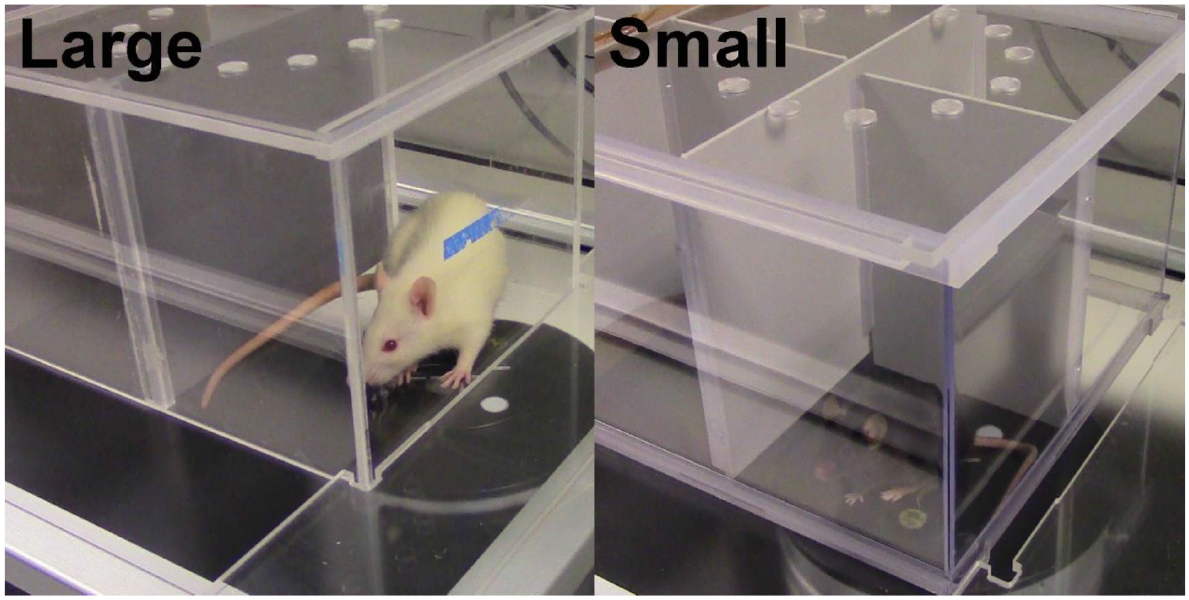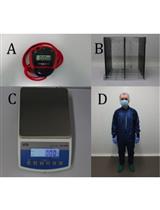- EN - English
- CN - 中文
Assessment of Thermal Pain Sensation in Rats and Mice Using the Hargreaves Test
使用Hargreaves测试法评估大鼠和小鼠的热疼痛感
发布: 2017年08月20日第7卷第16期 DOI: 10.21769/BioProtoc.2506 浏览次数: 15941
评审: Xi FengAdler R. DillmanAnonymous reviewer(s)
Abstract
The Hargreaves test is specifically designed to assess thermal pain sensation in rodents such as rats and mice. This test has been used in experiments involving pain sensitization or recovery of thermal pain response following neural injury and regeneration. We present here a step-by-step protocol highlighted with important notes to guide first-time users through the learning process. Additionally, we have also included representative data from a rat model of sensory denervation showing how the data can be analysed to obtain meaningful results. We hope that this protocol can also assist potential users in deciding whether the Hargreaves test is a suitable test for their experiment.
Keywords: Thermal pain (热疼痛)Background
The somatosensory system is responsible for processing sensory stimuli received from the environment. These sensory stimuli include pain, touch, pressure and vibration. To study how these stimuli are processed with the ultimate goal of repairing the system in the event of injury, neuroscientists have used a plethora of animal models and behavioral tests. Some of these experiments include administration of a noxious substance into the nervous system to investigate increased pain sensitivity (Zurowski et al., 2012), inducing a central or peripheral injury to the nervous system and then observing whether particular treatments promote neural regeneration (Andrews et al., 2009; Tan et al., 2012; Cheah et al., 2016), or developing in vivo neurodegenerative models with pathology in sensory neurons (Mellone et al., 2013). Whichever the case, having a suitable test to study the behavioral response of the animals is key.
Of all the sensations, pain is perhaps one of the most studied. Transmitted via different nociceptors, pain can be further categorized into different modalities such as thermal, mechanical and chemical. Depending on the experimental goal, all of these modalities can be assessed with a specific behavioral test. We present here our approach to the Hargreaves test which is a behavioral test designed for assessing response to thermal pain in rodents such as rats and mice (Hargreaves et al., 1988). Based on our experience, the Hargreaves test is relatively straight-forward and novel users can master it in a short period of time. With the aid of this step-by-step protocol, we hope to assist potential users in deciding if the Hargreaves test is a suitable test for them and also guide them through the learning process in an efficient manner.
Materials and Reagents
- Tissue paper
Note: The animals may urinate or defecate in the enclosure. Any fluid found on the framed glass panel should be cleaned immediately as this can affect the thermal conductance of the glass panel. - Disinfectant cleaning solution (e.g., 70% ethanol)
Use a disinfectant cleaning solution to remove animal odor, urine and/or feces after each session - Animals
Note: The activity level of each animal strain can affect the test tremendously as proper plantar placement of the paws is required for the test to be performed with reliable results. For whichever strain is chosen, habituation to the enclosure should be performed in the week prior to the start of experiment in order to acclimatize the animals to the setup as well as to take baseline readings. - For rats, the more docile Lewis strain may be ideal for the test because they have a tendency to move about their enclosures minimally compared to other strains, however they may fall asleep during the test resulting in delayed responsiveness. On the other hand, the more active Lister-Hooded strain may move too much, hence making the test difficult and/or potentially invalidating the results. Sprague Dawley rats have a tendency to have moderate activity level and are thus another ideal strain for this test.
- For mice, the C57BL/6 strain is generally more active than other strains such as BALB/c. The more active strains may make progressing with the test difficult although with sufficient acclimatization to the testing apparatus, any strain can be used.
- Sucrose/food pellets
Optional: Feeding animal a small handful (~5-10) of sucrose/food pellets may be helpful in reducing the movement and calming the animals in their enclosure.
Equipment
- Hargreaves test (Ugo Basile, catalog number: 37370 or Harvard Apparatus, catalog number: 72-6692 )
A complete set of the Hargreaves test should comprise the following components (Figures 1-3):- Controller
For manipulation of test settings such as infrared intensity, display of reaction time, and power input port - Emitter/detector vessel
With a fibre optic cable connecting to the controller for infrared emission and paw movement detection - Framed glass panel
For optimal thermal conductance, the glass panel should be kept clean and protected from damage - Animal enclosure
Large: holds up to 6 rats at a time
Small: holds up to 12 mice at a time - Large platform
- Supporting columns

Figure 1. A complete setup of the Hargreaves test
Figure 2. The Hargreaves test controller and emitter/detector vessel
Figure 3. Animal enclosure. The large enclosure can hold up to 6 rats, one animal in each compartment, while the small enclosure can hold up to 12 mice.
Procedure
- Controller
文章信息
版权信息
© 2017 The Authors; exclusive licensee Bio-protocol LLC.
如何引用
Readers should cite both the Bio-protocol article and the original research article where this protocol was used:
- Cheah, M., Fawcett, J. W. and Andrews, M. R. (2017). Assessment of Thermal Pain Sensation in Rats and Mice Using the Hargreaves Test. Bio-protocol 7(16): e2506. DOI: 10.21769/BioProtoc.2506.
- Cheah, M., Andrews, M. R., Chew, D. J., Moloney, E. B., Verhaagen, J., Fassler, R. and Fawcett, J. W. (2016). Expression of an activated integrin promotes long-distance sensory axon regeneration in the spinal cord. J Neurosci 36(27): 7283-7297.
分类
神经科学 > 行为神经科学 > 实验动物模型 > 大鼠
您对这篇实验方法有问题吗?
在此处发布您的问题,我们将邀请本文作者来回答。同时,我们会将您的问题发布到Bio-protocol Exchange,以便寻求社区成员的帮助。
Share
Bluesky
X
Copy link













